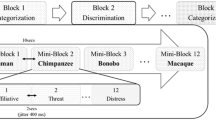Abstract
A central issue in the study of alloprimate vocalizations concerns the extent of the animal's control over vocalization production. Two competing models are the semanticity model which states that vocalizations contain an environmental referent, and the level-of-arousal model which states that vocalizations are an emotional product of differential internal states of arousal. One source of evidence bearing on this issue is the operant control of vocalizations by alloprimates. This paper presents a comprehensive review of 12 attempts to condition operantly alloprimate vocalizations. These 12 experiments are analyzed in terms of various subject and procedural variables, including the age, species and sex of the subject, and the type of task and reward used. The results of this analysis indicate the following: Primates are able to control their own vocal output with considerable success; species, age and sex variables place no restriction upon this ability. In addition, the appropriateness of the reinforcer influenced the success rate of the experiment. These results are interpreted as supporting evidence for the semanticity model of vocal production. Results are discussed in terms of an “ecologically-appropriate hypothesis.”
Similar content being viewed by others
References
Aitken, P. G. &D. A. Wilson, 1979. Discriminative vocal conditioning in Rhesus monkeys: Evidence for volitional control?Brain and Language, 8: 227–240.
Chivers, D. J., 1972. The siamang and the gibbon in the Malay Peninsula.Gibbon and Siamang, 1: 103–135.
Fantino, E. &C. A. Logan, 1979.The Experimental Analysis of Behavior: A Biological Perspective. W. H. Freeman, San Francisco.
Garcia, J., L. Clarke &W. Hankins, 1973. Natural responses to scheduled rewards. In:Perspectives in Ethology, Vol. 1,P. Bateson &P. Klopfer (eds.), Plenum Press, New York, pp. 1–41.
Hall, K. R. L. &I. DeVore, 1965. Baboon social behavior. In:Primate Behavior: Field Studies of Monkeys and Apes,I. DeVore (ed.), Holt, Rinehart & Winston, New York, pp. 53–110.
Haraway, M. M., E. G. Maples &S. Tolson, 1981. Taped vocalization as a reinforcer of vocal behavior in a siamang gibbon (Symphalangus syndactylus).Psychol. Reports, 49: 995–999.
Hinde, R. A., 1972. Comments on Part A. In:Non-verbal Communication,R. A. Hinde (ed.), Cambridge Univ. Press, London, pp. 86–98.
Lancaster, J. B., 1968. Primate communication systems and the emergence of human language. In:Primates,P. J. Jay (ed.), Holt, Rinehart & Winston, New York, pp. 439–457.
Leander, J. D., M. A. Milan, K. B. Jasper &K. L. Heaton, 1972. Schedule control of the vocal behavior of Cebus monkeys.JEAB, 17: 229–235.
Leger, D. W., D. H. Owings &D. L. Gelfand, 1980. Single-note vocalizations of California ground squirrels: Graded signals and situation-specificity of predator and socially evoked calls.Z. Tierpsychol., 52: 227–246.
Maples, E. G. &M. M. Haraway, 1982. Taped vocalization as a reinforcer of vocal behavior in a female agile gibbon.Psychol. Reports, 51: 95–98.
Marler, P., 1959. Developments in the study of animal communication. In:Darwin's Biological Work,P. R. Bell (ed.), University Press, London, pp. 150–206.
————, 1977. Primate vocalizations: Affective or symbolic? In:Progress in Ape Research,G. H. Bourne (ed.), Academic Press, New York, pp. 85–96.
———— &P. Mundinger, 1971. Vocal learning in birds. In:Ontogeny of Vertebrate Behavior,H. Moltz (ed.), Academic Press, New York, pp. 389–450.
Myers, R. E., 1976. Comparative neurology of vocalization and speech: Proof of a dichotomy. In:Origins and Evolution of Language and Speech,S. R. Harnad, H. D. Steklis & J. Lancaster (eds.), Annals of the New York Academy of Science, 280: 745–757.
————,J. A. Horel &H. S. Pennypacker, 1965. Operant control of vocal behavior in the monkey.Psychonomic Science, 3: 389–390.
Owings, D. H. &R. A. Virginia, 1978. Alarm calls of California ground squirrels.Z. Tierpsychol., 46: 58–70.
Peters, M. &D. Ploog, 1973. Communication among primates.Annu. Rev. Psychol., 58: 221–242.
Randolph, M. C. &B. A. Brooks, 1967. Conditioning of a vocal response in a chimpanzee through social reinforcement.Folia Primatol., 5: 70–79.
Rowell, T. E. &R. A. Hinde, 1962. Vocal communication by the rhesus monkey.Proc. Zool. Soc., Lond., 138: 279–294.
Salzinger, K., 1973. Animal communication. In:Comparative Psychology: A Modern Survey,D. A. Dewsbury &D. A. Rethlingshafer (eds.), McGraw-Hill Book Co., New York, pp. 161–193.
Seyfarth, R. M., D. L. Cheney &P. Marler, 1980. Vervet monkey alarm calls: Semantic communication in a free-ranging primate.Anim. Behav., 28: 1070–1094.
Shirek-Ellefson, J., 1972. Social communication in some Old World monkeys. In:Primate Patterns,P. Dolhinow (ed.), Holt, Rinehart & Winston, New York, pp. 297–311.
Skinner, B. F., 1938.Behavior of Organisms. Appleton-Century-Crofts, New York.
————, 1957.Verbal Behavior. Appleton-Century-Crofts, New York.
Struhsaker, T. T., 1967. Auditory communication among vervet monkeys. In:Social Communication Among Primates,S. A. Altmann (ed.), Univ. of Chicago Press, Chicago, pp. 281–324.
Sutton, D., C. Larson, E. M. Taylor &R. C. Lindeman, 1973. Vocalization in rhesus monkeys: Conditionability.Brain Research, 52: 225–231.
————,H. H. Samson &C. R. Larson, 1978. Brain mechanisms in learned phonation ofMacaca mulatta. In:Recent Advances in Primatology: Vol. 1, Behavior,D. J. Chivers &J. Herbert (eds.), Academic Press, London, pp. 769–784.
————,R. E. Trachy &R. C. Lindeman, 1981. Vocal and nonvocal discriminative performance in monkeys.Brain and Language, 14: 93–105.
Thomas, J. R., 1968. Fixed ratio punishment by time-out of concurrent variable interval behavior.JEAB, 11: 609–616.
Wilson, W. A., Jr., 1975. Discriminative conditioning of vocalizations inLemur catta.Animal Behavior, 23: 432–436.
Yamaguchi, S. I. &R. E. Myers, 1972. Failure of discriminative vocal conditioning in rhesus monkeys.Brain Research, 37: 109–114.
Yerkes, R. M., 1943.A Laboratory Colony. Yale Univ. Press, New Haven.
Author information
Authors and Affiliations
Additional information
This paper was first presented at the Rocky Mountain Psychological Association in April of 1984.
About this article
Cite this article
Pierce, J.D. A review of attempts to condition operantly alloprimate vocalizations. Primates 26, 202–213 (1985). https://doi.org/10.1007/BF02382019
Received:
Accepted:
Issue Date:
DOI: https://doi.org/10.1007/BF02382019




